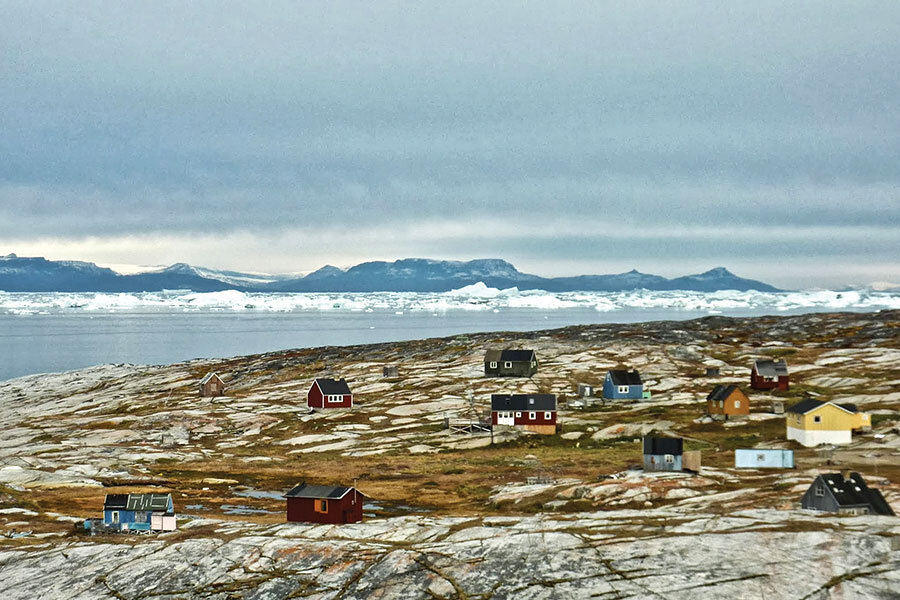I find warmth in Greenland
Loading...
I was about 5 when I first heard the word “Greenland.” And my interest grew from there. I can’t say exactly why, but it was undoubtedly a combination of many images that the word conjured up: remoteness, ice, polar bears, and Vikings.
Finally, after decades, I decided to go.
There is no easy way to get to Greenland from North America – only a seasonal flight from the far-flung Canadian province of Nunavut. But then, how does one get to Nunavut?
And so I flew first to Iceland, and from there took a prop plane from the heart of Reykjavík, flying three hours west to a place that, at first glance, was clearly misnamed: The east coast of Greenland was a forbidding landscape of black pinnacles poking through an expanse of ice and snow, with no sign of human habitation. I hugged my down parka close.
But then the plane angled toward the southern tip of the massive island, and everything changed. Much of the ice disappeared, replaced by broad fields of green. We landed, and when I stepped off the plane it was 73 degrees F. I regarded my parka dolefully.
One of my objectives in going to Greenland was to make contact with, and get to know, some native Greenlanders. I didn’t know how I would achieve this, but success came in an unexpected way.
There being few roads in Greenland, travel is mostly by boat. This is how I made my way to the tiny settlement of Qassiarsuk (pop. 89), site of some of the best-preserved Viking ruins in Greenland. When I got off the boat, I needed to hike the kilometer to the Illunnguujuk Hostel, where I had reserved a bed.
I arrived at a small, neat, white house not far from the edge of the fjord. A young couple and their toddler were out front, enjoying the sun and unusual warmth. This was my first native contact. Greenlanders speak their own Inuit language and learn Danish (the colonial language) in school. Many also speak varying levels of English. The young woman was one of these. But her English proficiency turned out to be anticlimactic.
When I identified myself, her eyes widened, and she said, “Oh.” There was a problem. Another wayfarer had arrived earlier and, mistaking him for me, they had given him my bed. There was no more space in the hostel. “But don’t worry,” she said, clearly concerned for my welfare.
My response: “I never worry.” And then I added, “I’ll take a walk to the Viking ruins. When I come back I’m sure you’ll be able to help me.”
When I did return, the family’s matriarch, a gracious grandmother of great presence, had come home. She was so embarrassed by the oversight that she had thrown herself into cleaning a tiny house the family owned on the banks of the fjord. “This is for you,” she said. And as if that weren’t enough, she invited me to eat supper with her family that evening – three generations under one roof. I had hit pay dirt.
That evening I sat down to a dinner of fresh, fjord-caught trout with an intact, loving, happy native family. The conversation proceeded in three languages. The themes ranged from the unusual warmth in Greenland, to the previous brutal winter, to the concern they felt for the changes in their country as the massive ice sheet thinned and outside interests cast envious eyes upon the newly revealed mineral wealth.
I ventured to remark that it must be a very difficult country to live in (the six months of darkness being one of the challenges), which they conceded. But they also wanted me to know that they could not conceive of living anyplace else. Home, after all, is home.
When I first set foot in Greenland I found myself all but overwhelmed by the emptiness, the vastness, and the silence. I had decided that I would make the most of Greenland during my visit, but that I would probably never return. And then I was taken into this Greenlandic home. I can now say that I have friends in Greenland, and that even a cold, empty, and silent landscape is worth visiting, so long as one has a warm and welcoming place to go.
All because of a misunderstanding.







